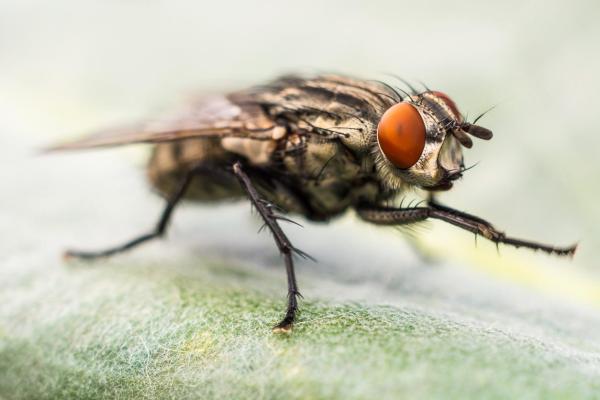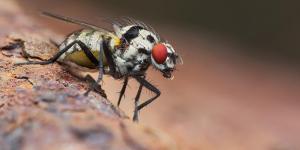Why Do Flies Rub Their Legs Together


Flies are a group of invertebrates that belong to the class Insecta and the order Diptera. The name Diptera derives from the Greek and means “two”. Flies are included in this group because unlike most insects, they have two wings instead of four. There are several species of flies and these are classified based on their anatomical differences. However, these species also differ in terms of habitat and the type of food they carry.
Many of these species have developed a close relationship with human beings. In fact, some of them depend on humans to feed and reproduce. At AnimalWised, we will explain some of the most important features of flies and answer the question of why flies rub their paws.
Do flies wash their hands?
Before diving into the subject, we would to clarify that flies do not have hands, they have legs. In fact, their legs play a very important role in their survival, since they are equipped with structures called sensilla or sensilias. These structures are receptors, which allow flies to fly, hunt for food, find a partner, among others. In most insects, these receptors are located in the antennae, but in the case of flies, they are located on the legs.
General information on flies
In order to know the answer to why flies rub their legs, first we need to review some of their most important features:
- Body: Their body is divided into three main parts, which are the head, thorax, and abdomen.
- Eyes: Their eyes are made up of thousands of individual visual receptors, each of which is a functioning eye in itself. As a consequence, flies possess great visual range and fast perception of movement.
- Wings: Unlike most flying insects, flies have got two wings instead of four. Their wings are thin, clear, and membranous. The hind wings evolved into structures known as halteres, which help flies to maintain their balance during flight.
- Mouth: The mouth parts of flies differ depending on the species. However, most of them are adapted for sucking. The majority of flies have maxillae, but other species also have mandibles.
- Complex sensory system: like many other insects, such as bees, flies have a complex sensory system that has gone through hundreds of millions of years of natural selection and that protects them from predators. This explains why flies are so hard to catch.
- Sensitive cells: flies posses sensitive cells on their legs, which allow them to perceive odors and flavors through chemoreception.
- Beneficial for the environment: there are several species of flies that carry pathogens that cause disease in people and domestic animals. However, there are also some species that are beneficial to the environment and that carry out important tasks. These flies are pollinators and also participate in the degradation of decomposing matter. They are also an indispensable part of food webs, and serve as food for other animals.
If you wish to know more about the importance of animals that are pollinators, keep reading this article on 15 animals that pollinate.
Do flies rub their paws?
As we have mentioned, flies have a complex sensory system, which is extremely useful not only to perceive the odors of a potential food source, but also to escape any type of danger.
Now, when asked why flies rub their legs, the answer may seem a bit strange. We usually associate flies with dirty places or decomposed matter. The truth is that flies rub their legs to remove particles that may have accumulated on them. In other words, they remove the dirt that has adhered. Their extremities are not completely smooth, on the contrary, the surface of their legs is similar to a bristle. When they rub them together, it facilitates their cleaning. Flies not only clean their legs, they also clean their head and antennae.
Depending on the species, flies can feed on plants, blood, decaying animal remains, human waste, and even other insects. For instance:
- The housefly (Musca domestica) consumes practically any food in the home.
- The fruit fly (Drosophila melanogaster) feeds only on fruits, especially if they are fermented.
- The horn fly (Haematobia irritans) sucks blood from cattle.
- Carnivorous flies, such as those belonging to the Asilidae family, are very aggressive and eat other insects.
As we have seen, flies have a very varied way of feeding depending on the specie. However, all of them come in contact with their food when feeding, making their legs dirty in the process. If we take into consideration that their sensory system is located on their legs, it is easy to understand why they need to keep their legs clean. If there are any particles on their legs, their sensors won't function correctly, and they rely on them for surviving.

Do all flies rub their legs?
Flies present certain anatomical differences, such as the type of their oral appliance, that makes it possible to identify them. However, other traits like their sensory system remain the same in all the species. This means that all flies depend on their legs and antennae to perceive the world around them. This is why they all require to keep their legs clean in order to improve their chances of survival. So, yes, all flies rub their legs and also clean their head and antennae.
If you want to read similar articles to Why Do Flies Rub Their Legs Together, we recommend you visit our Facts about the animal kingdom category.
- BBC World (2017). The sheer numbers of bacteria that house flies carry (and how they can spread disease) . BBC World. Available at: https://www.bbc.com/mundo/noticias-42137669.
- Hickman, C., Roberts, L., Parson A. (2000). Comprehensive principles of zoology . McGraw Hill Interamericana: Spain.
- Villegas, H. (2017). The house fly: Biology and control . Arthropods and Health, Vol. 8 No. 2. Available at: http://www.artropodosysalud.com/Publicaciones/No8-Dic2017/4Mosca_Domestica.pdf.






